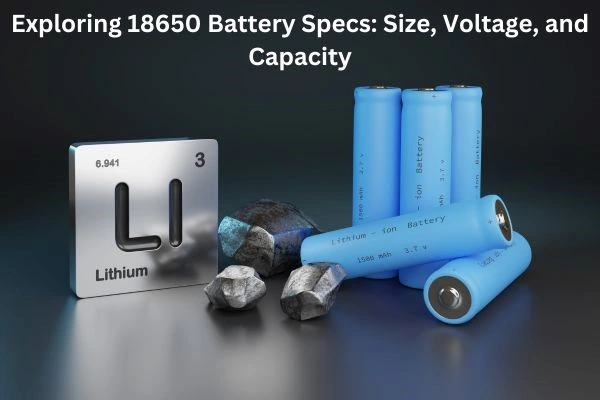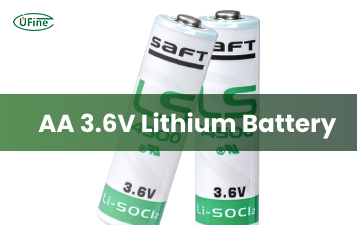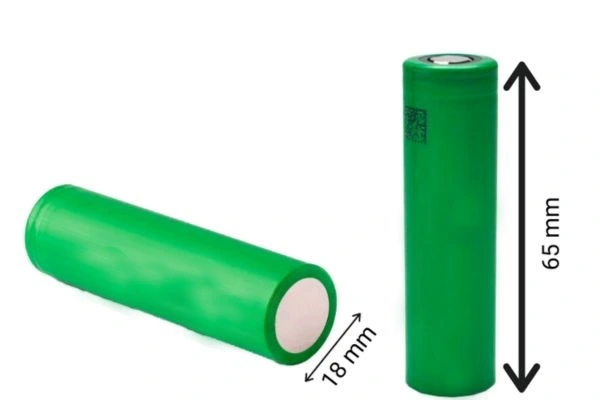Do you know what an 18650 battery is? Today, we are going to explore all about 18650 battery specs. After reviewing this article, you will better understand the 18650 battery size, voltage range, and capacity. By a detailed analysis of 18650 battery specs, you can find a suitable 18650 battery for your electronic device. You can utilize the maximum potential of the battery.

Part 1. What do 18650 battery specs include?
In 18650, battery specifications included several key aspects. The first is about the size of 18650 battery. These batteries come in many sizes to fit in every electric gadget. The second consideration is the 18650 voltage range. It starts from 2.5 to 4.2 volts, depending on a battery’s type and charging level. The last thing in the 18650 battery specs is the 18650 battery capacity. It ranges from 1500mAh to 3500mAh. Moreover, in 18650 battery specs, we will also look at the protected and unprotected batteries, as well as standard li-ion and high-power batteries.
Part 2. 18650 Voltage Range
Voltage is an electrical pressure that pushes the current through a circuit. The stronger push means a higher flow of electrons. We measure this flow in volts (V). In this part of the 18650 battery specs, we will talk about the 18650 voltage range of these cells.
A. Common voltages of 18650 batteries
The 18650 battery comes compact, but it delivers a powerful 3.7 volts. Due to its versatility, it is an ideal battery for most of the small electronic devices.
- Nominal voltage: In a normal full charge state, an 18650 voltage usually settles around 3.7 to 3.6 volts. A 3.7v indicates that the battery is fully charged and ready to use.
- Maximum charge voltage: The 18650 battery is rechargeable. Therefore, we should keep an eye on the charging volts of the battery. During the process of charging 18650 volts, it goes up to 4.2v. Going above 4.2 volts can damage the battery.
- Minimum discharge voltage: Like the maximum charge range, it has minimum discharge limits. So we must not drop the 18650 voltage below 2.5 volts. The battery will face issues like lifespan reduction and short backup in such conditions.
B. Comparison table of 18650 battery voltage
Understanding the voltage specifications is crucial when selecting and using 18650 batteries to ensure compatibility and safe operation within the device or application.
Here is a comparison table for the 18650 battery voltage:
| Voltage | Description |
|---|---|
| 2.5V – 4.2V | Actual voltage range during operation |
| 3.6V | Nominal voltage for lithium-ion 18650 batteries |
| 3.7V | Nominal voltage for lithium-ion 18650 batteries |
| 3.2V | Nominal voltage for lithium iron phosphate (LiFePO4) 18650 batteries |
| 4.0V – 4.2V | Fully charged voltage for lithium-ion 18650 batteries |
| 2.5V – 3.0V | Typical cut-off voltage for lithium-ion 18650 batteries (low charge state) |
| 2.0V – 2.5V | Minimum safe operating voltage for lithium-ion 18650 batteries |
If you want to install a new battery for your electronic device or are required for a new project, a fine battery can help you. It has a range of 3.7 volts 18650 batteries and also provides customized batteries for your needs.
Part 3. 18650 battery size
This lithium ion 18650 battery gets its name from its size. 18 millimeters is the diameter, whereas 65 millimeters is the length of the battery. The size of the 18650 battery is much more compact compared to the power-to-size ratio. Therefore, most electronic equipment uses these batteries for powering and operations.
Here is a table outlining the actual 18650 battery size:
| Specification | Dimension |
|---|---|
| Diameter | 18 mm |
| Length | 65 mm |
| Total Volume | Approximately 16.5 cm³ |
Key points of 18650 battery size
Diameter:
- The standard diameter of an 18650 battery is 18 mm (or 18.0 ± 0.2 mm).
- This is a consistent industry standard size.
Length:
● The standard length of an 18650 battery is 65 mm (or 65.0 ± 0.1 mm).
● This length specification is also consistent across 18650 batteries.
Total Volume:
- With a diameter of 18 mm and a length of 65 mm, the total volume of a standard 18650 battery is approximately 16.5 cm³.
- This small size makes 18650 batteries popular. You can use it in portable electronics and devices.
You should keep in mind that each manufacturer can offer some minor changes in the 18650 battery size. But it is a set standard size that defines 18650 batteries. Like many other companies, Ufine is one of the brands that can provide this versatile battery for powering your device.
Part 4. 18650 battery capacity
In this part of the 18650 battery specs, we will elaborate on the 18650 battery capacity. To compete with the needs of every small electronic device, 18650 offers a wide range of battery capacities. If the battery has a higher capacity, it will provide a longer backup.
Here’s a table explaining the 18650 battery capacity:
| Capacity (mAh) | Description |
|---|---|
| 1500 – 2000 mAh | Low capacity 18650 batteries used in flashlights, remote controls, etc |
| 2100 – 2600 mAh | Standard capacity 18650 batteries used in vape mods, toys, etc |
| 2700 – 3200 mAh | High capacity 18650 batteries used in small power tools, trimmers, etc |
| 3300 – 3500 mAh | Ultra-high capacity 18650 batteries, mobile phones, electronics cars, etc |
We use the term mAh to measure 18650 capacity, which means milliampere-hour. A higher mAh 18650 battery specs means it can store more energy during the charge. So, the battery will also perform for a longer time.
Part 5. FAQs
-
What are the typical capacity ranges for 18650 batteries?
The 18650 battery capacity ranges from 1500mAh to 3500mAh. If a battery has a higher mAh, it can store more energy in the charging process to deliver a long backup. The battery with high capacity does not need frequent charge compared to a lower mAh battery. -
Are all 18650 batteries the same?
No, 18650 batteries can vary in chemistry. Often, these batteries come in lithium-ion, lithium-ion phosphate (LiFePO4). Moreover, 18650 battery specs also vary from one model to another. Therefore, we should consider device compatibility before choosing any battery. -
How do I choose the right 18650 battery capacity for my device?
The only thing is matching the power and specs of the electronic device with the 18650 battery specs. The battery must be according to the device. You should also consider other factors such as runtime, size, and battery cost. -
Can I use different 18650 battery brands/models together?
We do not recommend you use batteries of different models and brands. Even if 18650 battery specs appear similar, the internal system of the battery can vary in resistance, charge, or discharge capacities. So, these can cause safety concerns if you put these batteries together.
Related Tags:
More Articles

What You Need to Know About AA 3.6V Lithium Battery
Learn all about AA 3.6V lithium batteries—voltage, size, capacity, uses, and the best replacements. Discover why they’re powerful, and highly reliable.
What Are Lithium Salts and Why They Matter in Battery Electrolytes
Lithium salts in electrolytes are key to battery performance, powering everything from phones to EVs and shaping the future of clean energy.
Lithium AAA Battery Guide: Power, Performance & Chargers
Explore lithium AAA batteries—voltage, capacity, weight, top brands, and more. Learn how to choose the best battery for your device and why it really matters.
How to Calculate Watts, Volts, and Amps (With Simple Formulas and Examples)
Learn how to calculate watts, volts, and amps for lithium batteries with simple formulas and examples, ideal for EVs, solar, and energy systems.
Comprehensive Analysis of U.S. Tariffs on Chinese Lithium Batteries
U.S. tariffs on Chinese lithium batteries in 2025 impact costs, supply chains, and EV, energy storage, and electronics industries globally.




